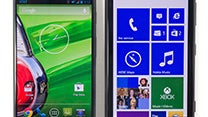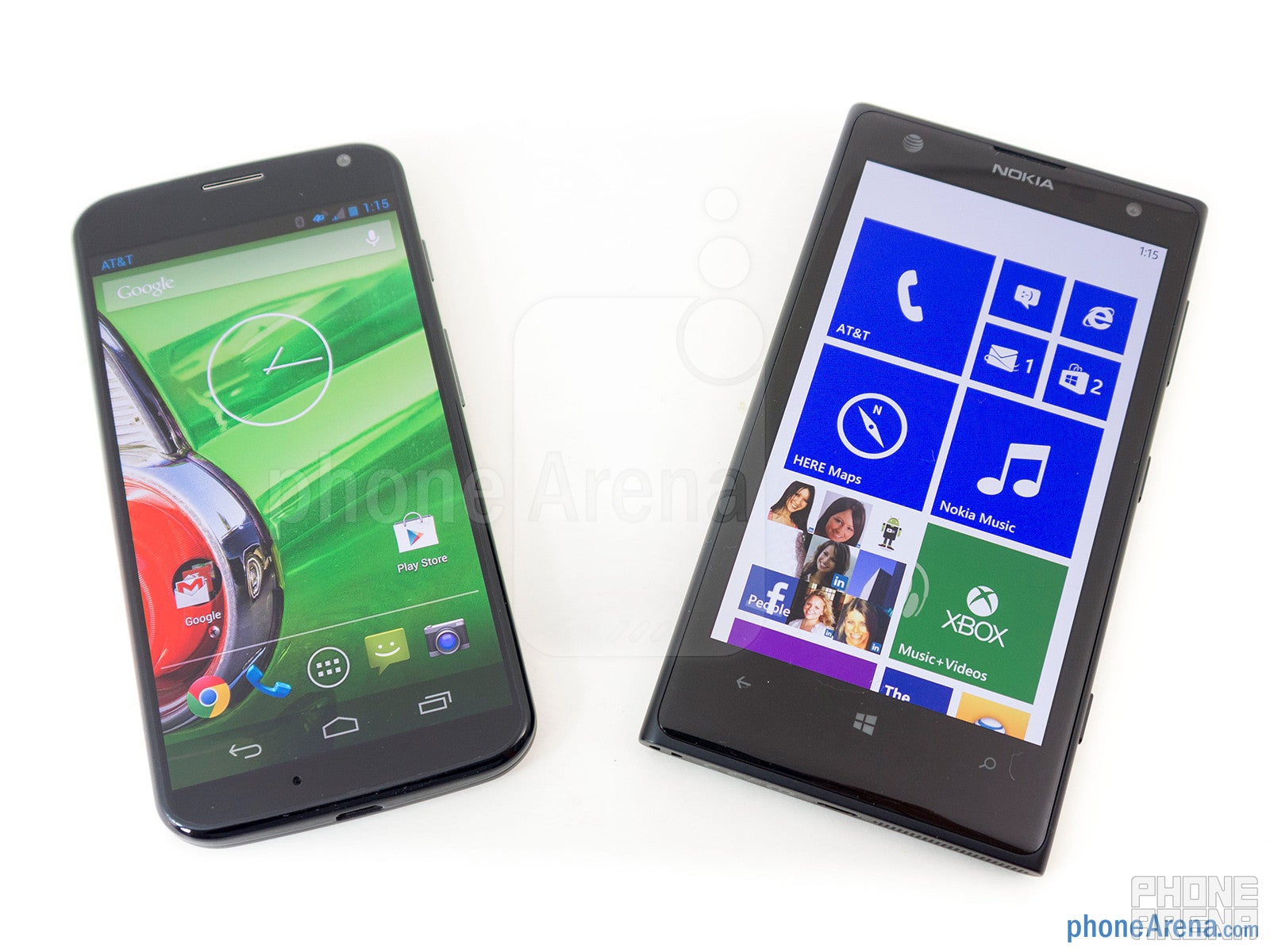Motorola Moto X vs Nokia Lumia 1020

Introduction
Flagship smartphones are in abundance as we speak, as the first half of the year saw some noteworthy models that still continue to turn heads, but the second half is already in full swing with an equally stellar lineup on tap. The Nokia Lumia 1020 has shown us that it’s THE Windows Phone 8 to go to, especially with its impressive 41-megapixel PureView camera in tow. Although the Moto X has yet to arrive officially onto the scene, it’s no doubt already stirring up plenty noise for a device that’s redefining the notion of a flagship device with its simplistic Android experience. Two great smartphones in the landscape no doubt, but it’s going to come down to which one has the greater drawing factor to win the hearts and minds of consumers all around.
Design
Without touching them, our eyes continue to fancy the design of the Lumia 1020 – it’s just not your average looking device, which helps it to tower over the Moto X. Then again, the customizable aspect of the Moto X’s design with Moto Maker will undoubtedly attract those who have a flavor for being different. However, as we grasp the two, it’s instantly recognizable that we favor the Moto X, as its compact size, curved rear casing, and soft touch coating provides the goods to make it more comfortable and natural to hold in the hand. In contrast, the Lumia 1020 is just bulky and top heavy by today’s flagship standards – albeit, it’s sturdier with its unibody matte polycarbonate body.
Display
For flagship devices, some people would think that these are behind the times, especially when they don’t pack that imposing 1080p resolution with their displays. To be frank, there’s not one that’s more than attractive than the other, as they boast all the same qualities. Specifically, it’s a 4.7-inch 720 x 1280 AMOLED display on the Moto X, and a 4.5-inch 768 x 1280 PureMotion HD+ with ClearBlack AMOLED panel on the Lumia 1020. Somewhat notable to mention, the slim bezels on the left/right sides of the Moto X’s display help to make it stand out more, since it helps in contributing to a smaller overall size than the Lumia 1020. Beyond that, everything else seems to be identical with one another – like their wide viewing angles, over-saturated color reproduction, and iridescent glow.
Motorola Moto X 360-Degrees View
Nokia Lumia 1020 360-Degrees View
Interface and Functionality
Always the pickle to answer directly, it’s the platform experiences of the two that greatly define them – one being Android 4.2.2 Jelly Bean, the other Windows Phone 8. In terms of the visuals and presentation, it’s a matter of personal preference, seeing that they both have characteristics to appease us in more ways than none, but when it comes to their apps ecosystem, we can’t help but vouch that the Moto X has the advantage, just because Android as a whole has more diversity. In addition, the Moto X handles notifications and other aspects of the platform functionality in a more practical manner. Sure, the dynamic live tiles of the Windows Phone 8 start screen handles notifications, but they can be scattered – whereas we’re given a centralized area for that with the Moto X.
Being a Nokia-made device, the Lumia 1020 benefits over other Windows Phones from rival companies, but the overall package is still lagging behind what the Moto X brings with its simplified Android experience. For example, the Moto X’s Touchless Controls, Active Display, and Motorola Connect, and Motorola Assist features all combine together to make the experience seamless and simple.
On the surface, the core organizer apps with both phones function in the same manner, but Google Now combined with the Moto X’s Touchless Control feature delivers us a useful digital personal assistant that’s all accomplished via voice – minimal physical interaction needed with it. The Lumia 1020’s Bing service simply pales in comparison with its offering. Yes, it’s able to accomplish basic things, but lacks the all-encompassing experience of Google Now.
Despite having the larger screen, it’s the Lumia 1020 that’s boasting the more spacious keyboard layout, as buttons are no doubt bigger. Aside from that one prominent thing, the two function in the same manner to make the experience equal to one another, seeing that they exhibit the same responsiveness and great auto-correct features.
Processor and Memory
Specs-heads might yawn at these two, since they’re regarded as last-generation hardware, but these two buck the notion that you need high-end gear to have tight performances. In fact, for dual-core processor packing smartphones, we can’t complain about their speedy operations. For the Moto X, it features a modified dual-core 1.7GHz Qualcomm Snapdragon S4 Pro processor with 2GB of RAM – while the Lumia 1020 is outfitted with a dual-core 1.7GHz Qualcomm Snapdragon S4 Plus processor with 2GB of RAM. Everything about their performances is nearly identical, as they handle elementary tasks with little fluff, but we’ll give the Moto X the slight advantage with its snappier response. It’s not extraordinarily better per se, but noticeable nonetheless.
Unfortunately, neither offers expandable storage, which means we’re left to strictly deal with their internal capacities. The Moto X will be available in both 16GB and 32GB options, but the Lumia 1020 is solely offered with 32GB.
Internet and Connectivity
No surprises here folks, it’s such a pleasure to surf the web with these powerhouses. For starters, they feature lightning fast 4G LTE connectivity to load complex web sites in a jiffy. Furthermore, they complement the experience with their smooth navigational controls and quick page rendering. It doesn’t dampen the experience, but we do notice that there’s a little bit of jitteriness with the Lumia 1020’s pinch zooming performance.
When you’re a flagship, we’d be inclined to believe a device would be available in GSM and CDMA flavors, which is what we’re going to see with the Moto X. However, the Lumia 1020 is packing GSM connectivity – with no indication of CDMA support with other variants. Nonetheless, they stuffed with all of the usual connectivity features we’d come to expect – like aGPS, Bluetooth, Wi-Fi, and NFC.
Camera
Pounding it into the ground like no other, the Nokia Lumia 1020 is without question the device that caters to hardcore shutterbugs. In one corner, the Moto X takes the approach of simplicity when it comes to snapping photos in the moment without any distractions, but the Lumia 1020 provides us with a deeper set of manual controls and various shooting modes. Depending on your stance, either camera experience will suit you – albeit, it never hurts to have a multitude of functions within our reach. Even though we can access the camera app instantly on the Lumia 1020 by long-pressing the shutter key, the Moto X’s Quick Camera Capture feature is also a neat alternative.
Forget about it folks! There’s simply no comparison in this category, as the Nokia Lumia 1020’s beefy 41-megapixel PureView camera is light years ahead of what the 10-megapixel Clear Pixel camera of the Moto X. Every single aspect in the camera quality department goes to Nokia’s pride and joy, which it should no doubt, especially when it defining aspect is taking photos. Frankly, there’s a ton of things to like with the Lumia 1020’s snapshots – like its higher level of fine detail, superb bokeh effect with macro shots, neutral color reproduction, and excellent low light quality. Heck, even its Xenon flash is more potent than the Moto X’s LED flash.
Furthermore, the Lumia 1020’s high definition 1080p video recording trumps the quality put out by the Moto X – and the Moto X’s results are pretty darn good on its own! Yet again, the Lumia 1020 wins in every single category, but even better, we appreciate that it can capture video in 24 frames per second too for that dreamy cinematic look with its quality.
Multimedia
Both music players are pretty snazzy on their own, so we don’t necessarily find one to be better with their presentations or functionality. Taking a peek at the Moto X, which has its speaker firing audio out of its rear, it doesn’t particularly do a better job of dispersing audio. In contrast, the Lumia 1020 has its speaker on the bottom right corner – enabling its tones to be more robust and full bodied.
When these two are packing similar displays and processors, we don’t find one to be superior for watching high-definition videos. In fact, playback is buttery smooth with both – with almost zero instances of slowdown or lag. Add in the fact that their AMOLED based displays have an iridescent glow to them, they undoubtedly have the potency to keep our eyes firmly on them.
Call Quality

Battery
Somehow it can be attributed to Motorola’s optimizations with the Android experience, but we find the Moto X producing the longer battery life with its 2200 mAh stacked battery. Giving us a solid 24 hours of normal usage, it edges out the 18 hours we’re able to summon up from the Nokia Lumia 1020’s slightly smaller 2000 mAh battery.
Conclusion
It might have a head start, but the Nokia Lumia 1020’s $300 on-contract starting price point is still tough to swallow – you’ll save a cool $100 picking up the base mode of the Moto X for $200 on-contract. Putting things into perspective, the biggest thing going for the Lumia 1020 is its superior 41-megapixel PureView camera, which is still unrivaled in the photo and video taking departments. Although it doesn’t make drastic strides in one particular category, the Moto X manages to capture our attention for its balanced performance and offerings. It still takes some sharp looking photos and videos to contend admirably, but when we take into consideration the practical enhancements found with its customized Android experience, it really makes us gravitate to its worth over what the Lumia 1020 has on the table with its Windows Phone 8 experience. To top it off even more, Android as a whole has a deeper ecosystem than Windows Phone 8.
Motorola Moto X vs Nokia Lumia 1020:

Follow us on Google News













Things that are NOT allowed:
To help keep our community safe and free from spam, we apply temporary limits to newly created accounts: